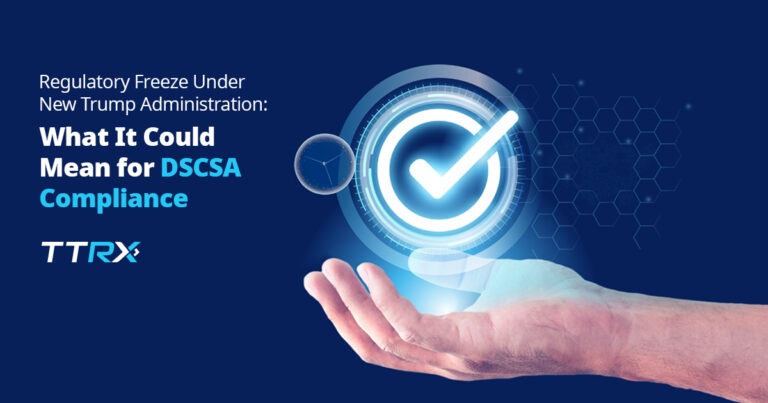Drug supply chain trading partners, including manufacturers, wholesalers, distributors, pharmacies, and other pharmaceutical related businesses have been adapting to the changes outlined in the DSCSA regarding how trading partners handle the serialization and traceability of pharmaceutical products. As we’ve said farewell to phase I of the DSCSA, it’s time to look ahead to phase II, which includes a focus on interoperability for the industry.
How Trading Partners Can Look Ahead and Prepare for Interoperable Technology
Drug supply chain trading partners, including manufacturers, wholesalers, distributors, pharmacies, and other pharmaceutical related businesses have been adapting to the changes outlined in the DSCSA regarding how trading partners handle the serialization and traceability of pharmaceutical products. As we’ve said farewell to phase I of the DSCSA, it’s time to look ahead to phase II, which includes a focus on interoperability for the industry.
Currently, the development of interoperable technology that can be implemented on an industry wide scale is one of the most ambitious goals of the DSCSA. It’s something that will eventually affect every trading partner, and the sooner we can all prepare for it, the better. Let’s take a look at what exactly the integration of interoperable technologies means for trading partners, and what they should be doing today to prepare for the changes coming in the future.
Understanding the Complexities of Interoperability
The first goal that we’re working towards with interoperability is the seamless exchange of transactional information among drug supply chain trading partners. By the time 2023 rolls around, and with it the anticipated full implementation of the Drug Supply Chain Security Act, every operation in the drug supply chain will need the capabilities to easily and quickly communicate accurate information to their downstream drug supply chain trading partners, including details such as the pharmaceutical’s serial number, national drug code (NDC), the quantity being exchanged, and in the event of a query, be able to access the pharmaceutical’s history that existed before they gained possession.
Considering the size of the drug supply industry, the sheer volume of the pharmaceuticals that travel through the system, and how in depth these systems need to be, it’s easy to see why interoperability has been seen as such a daunting task in the industry.
“ The goal of phase II of the DSCSA, and the focus on interoperability, is to eliminate the need for this type of extensive paperwork and record keeping, all without compromising access to information.”
We’re at a transitional period in the implementation of the DSCSA. We’ve passed through phase I and are still tweaking and adapting as we go to maximize efficiencies, while embarking on phase II – which is heavily focused on interoperability. As it stands currently, when a pharmaceutical moves along the chain from one trading partner to another, a record of its transactional history must follow.
For example, by the time a pharmaceutical reaches the hospital setting, there should be an attached full and accurate history of each transaction from the point of the manufacture on through the chain. The goal of phase II of the DSCSA, and the focus on interoperability, is to eliminate the need for this type of extensive paperwork and record keeping, all without compromising access to information.

The elimination of this “trail” is a huge benefit of the DSCSA, at least from an operational perspective. Ideally, this streamlines operation processes and reduces the amount of resources that go into record keeping. However, to benefit from this, the industry needs to be strongly focused on developing technological solutions that allow each trading partner to gather information and put together the transactional history of any pharmaceutical in real time, or at least as close to it as possible. In this type of system, interoperability is essential but there are other complexities that come into play, such as security concerns among trading partners who may not be familiar with each other or lack a reputation of trustworthiness.
Interoperable solutions are being worked on for the pharmaceutical industry as we speak, and the new technology is a major focus of the FDA. That said, we still have a ways to go, and drug supply chain trading partners should be taking steps to better prepare for the challenges and changes ahead.
How Can Drug Supply Chain Trading Partners Prepare for Interoperability
By 2023, we expect the entirety of the drug supply chain to be functioning within an interoperable solution for the seamless, secure, and reliable exchange of information. However, it there’s one thing we’ve learned from navigating our way through phase I of the DSCSA, it’s that meeting goals is often a more complex and time consuming process than originally expected – something that has been evident by the FDA’s willingness to grant extended windows for compliancy on key milestones.
It’s going to take time to get the entire industry working together using interoperable technology that must perform as a one size fits all solution. Drug supply chain trading partners should be working today to prepare for the changes ahead and ease the transition. Doing this involves working toward solutions on an individual operational level, as well taking part in the influencing how the industry as a whole approaches and adapts to interoperable technology.

Currently, while interoperable technology is being developed, drug supply chain trading partners need to ensure they’re doing their part to meet track, trace and serialization expectations. They need to ensure that they’re complying with identifiable codes, that these codes are being inputted properly, that accurate records of transactional information are being stored in a database for at least six years, and that each product that moves from one drug supply chain trading partner to another does so following track and trace standards.
This is also a good time for trading partners to look at their operations and identify areas that lack in efficiency. The simplest and easiest way to adopt new technology is simply to be prepared for it. Having manual processes in place to track pharmaceuticals, keep transactional information in a database, and quickly respond to queries will eliminate an excessive use of resources and enable trading partners to better devote their time and energy to adopting interoperable technology
Free VRS Evaluation
With the deadline fast approaching, contact TrackTraceRx today to receive a free evaluation of your VRS strategy to comply with the DSCSA Saleable Returns. This free consultation will allow you to have a piece of mind that you are following the correct procedures in order to meet ALL DSCSA requirements. TrackTraceRx will also provide you with a FREE Standard Operating Procedure (SOP) template which is required by the DSCSA during a FDA inspection.




